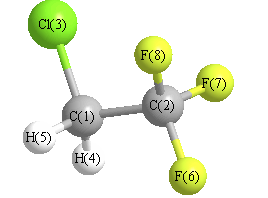Vibrational Frequencies calculated at QCISD/6-31G*
| Mode Number |
Symmetry |
Frequency
(cm-1) |
Scaled Frequency
(cm-1) |
IR Intensities
(km mol-1) |
Raman Act
(Å4/u) |
Dep P |
Dep U |
|---|
| 1 |
A' |
3145 |
2995 |
7.82 |
|
|
|
| 2 |
A' |
1523 |
1450 |
21.15 |
|
|
|
| 3 |
A' |
1429 |
1360 |
64.02 |
|
|
|
| 4 |
A' |
1345 |
1281 |
134.33 |
|
|
|
| 5 |
A' |
1236 |
1177 |
237.73 |
|
|
|
| 6 |
A' |
885 |
843 |
25.18 |
|
|
|
| 7 |
A' |
827 |
787 |
18.61 |
|
|
|
| 8 |
A' |
647 |
616 |
27.58 |
|
|
|
| 9 |
A' |
538 |
513 |
6.69 |
|
|
|
| 10 |
A' |
363 |
346 |
0.59 |
|
|
|
| 11 |
A' |
190 |
181 |
1.65 |
|
|
|
| 12 |
A" |
3212 |
3058 |
0.62 |
|
|
|
| 13 |
A" |
1375 |
1309 |
160.89 |
|
|
|
| 14 |
A" |
1179 |
1122 |
88.66 |
|
|
|
| 15 |
A" |
956 |
910 |
9.63 |
|
|
|
| 16 |
A" |
533 |
508 |
2.30 |
|
|
|
| 17 |
A" |
356 |
339 |
1.22 |
|
|
|
| 18 |
A" |
108 |
103 |
3.20 |
|
|
|
Unscaled Zero Point Vibrational Energy (zpe) 9923.4 cm
-1
Scaled (by 0.9523) Zero Point Vibrational Energy (zpe) 9450.0 cm
-1
See section
III.C.1 List or set vibrational scaling factors
to change the scale factors used here.
See section
III.C.2
Calculate a vibrational scaling factor for a given set of molecules
to determine the least squares best scaling factor.
